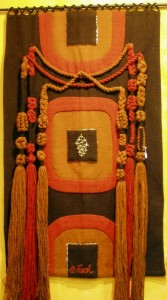

Destinations
Experiences
 |
L A
D A T C O T O U R
S |
 |
||||||||
| HOME | South America | Falkland Islands | Antarctica | Unique Destinations |
Unique Experiences |
Newsstand | ||||
 An Olga Fisch designed tapestry from FOLKLORE |
Quito Shopping
|
Shopping in Quito is a feast for the eyes, often resulting in a bag full of purchases being added to your luggage.
In Quito you can get a good overview of what the country has to offer by strolling Avenida Amazonas which is lined with shops and shops and shops, all filled with an array of handicrafts - carved items, ponchos, sweaters, scarves, rugs, ceramics, gourds, textiles of all kinds. Just one block off Avenida Amazonas, running parallel and near the Colon Hilton is a large handicraft market.
On Sundays in El Ejido Park, just across from the Colon Hilton Hotel, there is a handicraft and art market, with many artists displaying original art works.
Among the special places to explore is FOLKLORE, Olga Fisch. Here is "About Olga Fisch" - in their own words:
A Hungarian Artist and a collector per excellence, Olga Fisch immigrated to Ecuador in 1939 and soon recognized the vast potential of the folk artisans of Ecuador. She was a humanist visionary, whose main attribute, in her own words, was to "know how to recognize quality in a work of art ". She began working with indigenous artisans, throughout the country drawing upon the artists `visions of their natural world and helping them to refine their artistic expression to bridge the gap between folk art and traditional fine art.One of the popular items to buy in Ecuador, and abundant in Quito, is the Panama Hat. While actually made in and around Cuenca, the "toquilla straw hat" is indeed a "hat with a history". Here is the story of how this hat got it's name - in the words of Footprint Handbook :Ecuador & Galapagos Handbook":
Where does the Panama hat come from? Ecuador, of course! The confusion over the origin of this natty piece of headwear dates back over 100 years.
The major trading post for South American goods in the 19th and early 20th century was the Isthmus of Panama, the quickest and safest seafaring route to Europe and North America. Sugar, fruit, minerals, cloth and dozens of other products, including Ecuadorian straw hats, passed through the Isthmus.
In the mid 1800's gold seekers from the East Coast of the US heading for the California gold rush picked up the straw hats on their way West. 50 years later, workers on the Panama Canal found these hats ideal for protection against the tropical sun and, like the forty-niners before them, named the hats for their point of purchase, rather than their place of origin. The name stuck.
The hats are woven from the fronds of the plant that grows in the low hills west of Guayaquil. The hats are woven from the very fine fronds, which are boiled, then dried in the sun before being taken to the weaving centers - Montecristi and Jipijapa in Manabi and Azogues, Biblian and Sigsig in Azuay. Montecristi, though, enjoys the reputation of producing the best superfinos. These are Panama hats of the highest quality, requiring up to 3 months work. They are tightly woven, using the thinnest, lightest straws. When turned upside down they should hold water as surely as a glass and when rolled up, should be able to pass through a wedding ring.
From the weaver, the hat passes to a middleman, who then sells it to the factory. The loose ends are trimmed, the hat is bleached and the brim ironed into shape and then softened with a mallet. The hat is then rolled into a cone and wrapped in paper in a balsawood box ready for exporting.